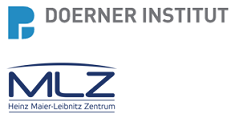Speaker
Description
A large number of written and illustrated papyri from ancient Egypt have survived through the ages, carrying stories, practices, and numerous details of the everyday life in Egypt several millennia ago. We have investigated a series of illustrated papyri from the collection of the Champollion museum (Vif, département de l’Isère, France) showing scenes from the Book of the Dead, a document essential to prepare for the afterlife in Ancient Egypt (Fig. 1a). To do so, optical microscopy, Raman spectroscopy, and synchrotron X-ray powder diffraction and fluorescence were combined. The X-ray diffraction data proved to be challenging, reflecting the high heterogeneity of the different colored regions where a mix of organic and inorganic compounds of variable microstructure and crystallinity co-exist. Despite this, we show that through mixed Rietveld and Pawley refinement procedures (Fig. 1b), we can access part of the quantitative and microstructural information contained in the diffraction data, thus allowing deeper knowledge to be gained on pigment preparation, illustration technique, and degradation process [1].
The vivid colors still visible today come from the use of red hematite, blue cuprorivaite (also known as Egyptian blue), green malachite, yellow orpiment, white gypsum and lead white, and black carbon. The illustration sequence developed at the New Kingdom period and extensively applied to mural paintings was clearly transposed to papyrus illustration, with a red preparatory drawing, followed by a coloring process, and finally the drawing of the final black contour. Besides the classic nature of the pigments and the highly standardized illustration technique, we also highlight the free and careful choices made by Egyptian craftsmen in the coloring of the illustrations, with specific pigments and mix of pigments to obtain various shades, adapting to the scene and decorative elements to color.
Despite the inorganic nature of most of the pigments, a global degradation process affecting most of the colored regions has also been taking place, sometimes altering the original color, or revealed by the presence of specific degradation compounds. Indeed, in addition to the main pigments, we also identified several sulfate-, chloride-, and oxalate-based phases, clearly resulting from a degradation process. As an example, malachite (Cu2CO3(OH)2), used as a green pigment, transformed into atacamite (Cu2Cl(OH)3) and moolooite (Cu(C2O4),nH2O) (Fig. 1b). These ancient illustrated papyri have been exposed over centuries to a series of environmental variations such as temperature or humidity through the alternance of seasons, and their current degradation state can be used to gain insights into the long-term behavior of such materials and find appropriate conservation measures to transmit this unique Heritage from Ancient Egypt to future generations.
[1] Autran et al., Scientific Reports, 13, 524, 2023.
Figure 1. a) The first fragment (PAP-12) from the Champollion collection represents a cobra with a solar disk on his head standing in front of a papyriform column. On the second fragment (PAP-6), the supposed deceased faces the god Ra, deity of the sun, with his hands raised in adoration. b) Mixed Rietveld and Pawley (p) refinements against an X-ray diffraction pattern collected at the ESRF-ID22 beamline in the green region of the column (PAP-12) (Rwp: 0.77%, Rexp: 0.53%, wavelength: 0.4009 Å).

